Red clothing, carnival songs, the arrow sash, Bonhomme’s Effigy and the Party Spirit are all time-honoured traditions dating back to the origins of the Carnival.
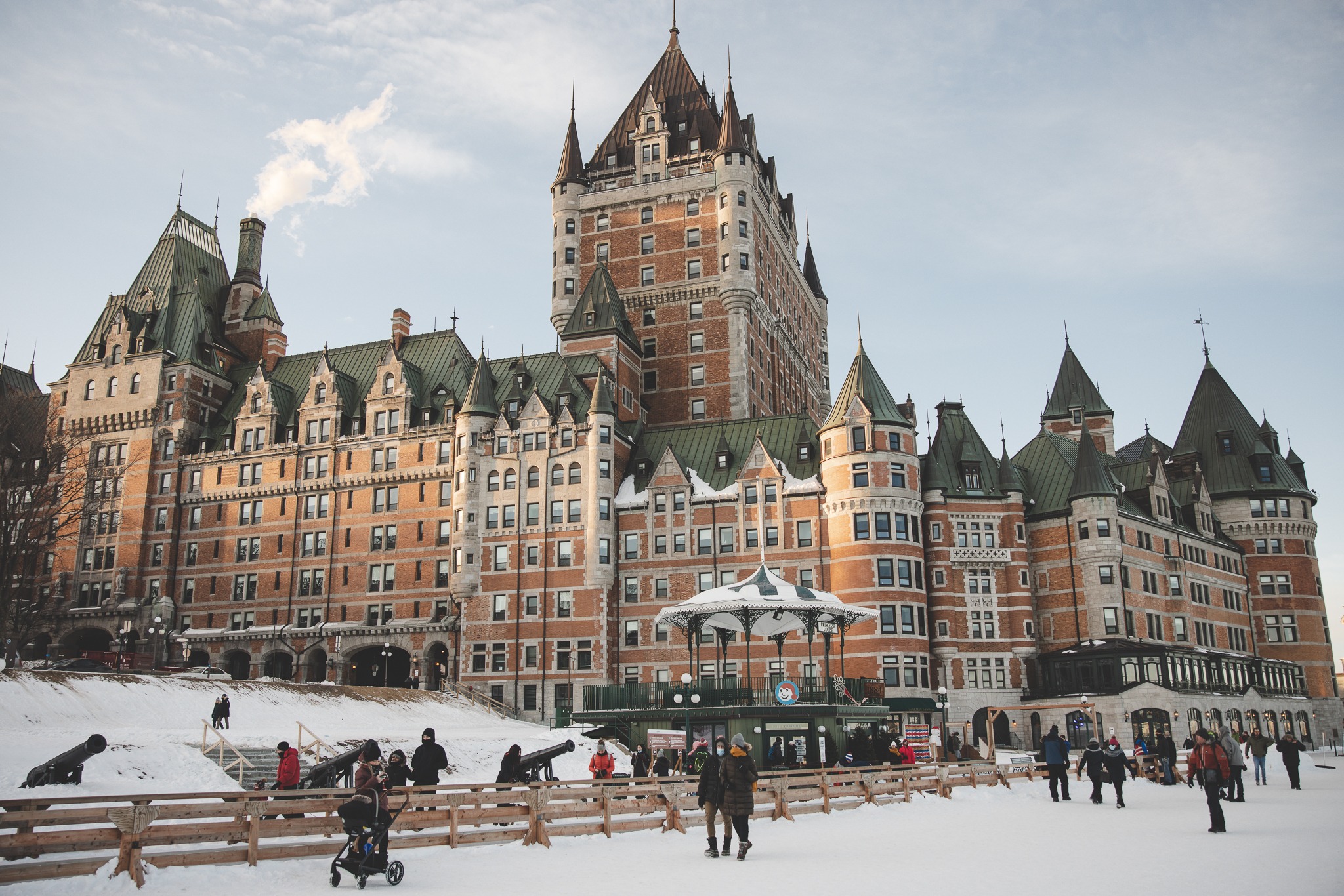
A bit of history…
The tradition of celebrating from the end of January until mid-February has been around for a long time! In Quebec City, the world’s snow capital, the first major winter carnival made its debut in 1894.
A population often faced with harsh winters decided to put on a snow festival to warm their hearts. Interrupted by the two world wars and the Great Depression of 1929, the Carnival resurfaced sporadically until the second half of the century. In 1954, with a view to promoting the economic development of the Old Capital, a group of business people relaunched the festivities and chose Bonhomme as the event’s representative. The first edition of the Québec Winter Carnival took place in 1955 and became a must-attend event for the people of Quebec City and the impetus behind the city’s winter tourist activities. Today, the Québec Winter Carnival is undeniably a major winter event and continues to be a driving force in Quebec’s winter life.
In 1954, in a perspective of economic development of the Old Capital, a group of business people revived the party and chose Bonhomme as representative of the event. The first edition of the Quebec Winter Carnival took place in 1955. The Carnival became a must-attend event for the people of Quebec City and the driving force behind the winter tourist activity in the city. Today, the Quebec Winter Carnival is undeniably a major winter event and remains a driving force in Quebec’s winter life.
The arrow sash
It is largely thanks to the Québec Winter Carnival that the arrow sash still exists in Quebec society today. In the 19th century, this belt was used to tighten coats around the waist to prevent the cold from creeping in while also providing back support.
Many believe that the arrowhead technique is of Aboriginal origin whereas it is rather a mixture of two methods: Native American weaving and French-Canadian weaving. The Aboriginals helped to preserve the arrow sash by trading their furs in exchange for the sash. The Quebec arrow sash is unique in the world with its arrows rather than chevrons, as in the universal technique.
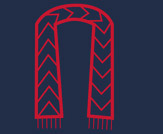
Place your sash around your waist, chevrons from the left band pointing downwards.
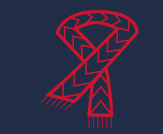
Cross the two bands of the sash keeping the left band on top.
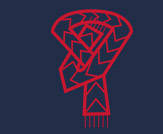
Make a loop, by putting the left band under the band on the right, then flap it forward.
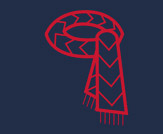
Final result: Chevrons point downwards. Wear the sash on your left, on the same side as your heart.
The Salut Bonhomme song
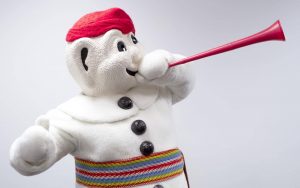
The trumpet
Nothing better than these long red or blue trumpets to liven up the mood along the Carnival Night Parade route! Come on, dress in red, tie your sash and put on your tuque, because in Quebec, it’s a tradition to celebrate!
Did you know that the Carnival trumpet can produce up to 114 decibels?
- 18941894
1894
First Carnival in Quebec City.
- 19281928
1928
The Automobile Club of Quebec is justifiably proud of this ice sculpture in front of its offices on the corner of Buade and des Jardins Streets.
- 19541954
1954
Foundation of the contemporary Québec Winter Carnival by Wilbrod Bherer, Louis-Philippe Plamondon and Louis Paré.
- 19551955
1955
First Québec Winter Carnival and first appearance of Bonhomme Carnaval. The year 1955 is also remembered for the crowning of the first Carnival Queen, Estelle Côté.
- 19561956
1956
Whether in Upper or Lower Town, during the day or at night, the Carnival Parades have always amazed spectators. The year 1956 is also remembered for the Mardi Gras Ball and the ski race on the Côte de Salaberry.
- 19581958
1958
The canoe race takes place in the worst conditions in the history of this classic. Only 4 of the 21 teams make it to the finish line.
- 19591959
1959
A new financing concept was created: the Carnival Candle. For the first time, the Queen is elected through a random draw. The Soapbox Derby becomes part of the program.
- 19601960
1960
In 1960, the first Carnival Street is born: Sainte-Thérèse Street with its snow monuments.
- 19611961
1961
The first barrel jumping competitions take place. Motorcycle races on ice begin and are held until 1997.
- 19641964
1964
Voûtes Chez Ti-Père, a gathering place that would last for 25 years, opens on Sainte-Thérèse Street. The name Bonhomme Carnaval and his image also become registered trademarks in 1964.
- 19661966
1966
The Order of the Duchesses is created, and the first women’s team takes part in the canoe race.
- 19691969
1969
Visit from Princess Grace of Monaco.
- 19701970
1970
The Pee-Wee International Hockey Tournament has long been associated with the Carnival.
- 19731973
1973
First International Snow Sculpture Competition. The Ice Palace is built in front of the Parliament Building, rather than in Place d’Youville.
- 19741974
1974
A mustache contest is organized and remains part of the Carnival until 1985. Bobino (Guy Sanche) and Bobinette come to Quebec City to present four shows at the Armoury. Two weeks before the 20th Carnival, the roof of the Workshop collapses under the weight of snow and ice. The public’s sympathy manifests in record sales of close to 340,000 candles, helping cover many of the losses!
- 19761976
1976
The sport of ice canoeing was created thanks to the Carnival.
- 19791979
1979
It’s the 25th Carnival! Since there was no ice supplier in the region, the Palace was made of snow until 1992.
- 19811981
1981
An eccentric hairstyle and makeup contest is held until 1991. In this photo: The 1981 Ice Palace.
- 19831983
1983
The wax candle is replaced by a “scratch-and-win” candle ,similar to a lottery ticket (until 1994). The first Night Parade in Charlesbourg.
- 19871987
1987
First Snow Bath at the Carnival.
- 19971997
1997
The move to making the Carnival more family-oriented begins. Disappearance of the Duchesses and Queen. The Duchies are replaced by Bonhommies.
- 19981998
1998
The Knuks, mischievous little jokers from the North, make their appearance. These teasing and cheeky characters have the talents of magicians, dancers and pranksters.
- 20042004
2004
The Carnival celebrates its 50th anniversary and presents an exhibition at the Musée du Québec
- 20082008
2008
The Carnival is the very first event to celebrate the 400th anniversary of Quebec City. A new Parade is specially created for the occasion.
- 20102010
2010
Carnival nightlife is enhanced by a huge outdoor stage on the Plains of Abraham.
- 20122012
2012
Bonhomme’s Ice Palace moves to Place Desjardins, on the Plains of Abraham. A huge igloo-shaped dome allows people to dance in a festive atmosphere!
- 20132013
2013
The LUMOCITÉ project, a projection mapping initiative, lights up four buildings near the city center. A huge structure of Bonhomme in front of the Parliament Building and the winter Festibière are among the new novelties.
- 20142014
2014
The Carnival celebrates its 60th anniversary. The Duchesses return after an 18-year absence. Their Duchies line the borders of Quebec City’s boroughs. Bonhomme’s Ice Palace is once again in front of the Parliament Building and for the first time, the public is invited to visit Bonhomme’s quarters.
- 20152015
2015
Bonhomme’s Winterland settles on the Plains of Abraham. The Bulles, Whisky & Cie event is held for the first time and is a great success. The Parades are renewed with a northern theme.
- 20162016
2016
Singer-songwriter Louis-Jean Cormier plays his greatest hits alongside the Quebec Symphony Orchestra at the Videotron Centre for the opening ceremony of the 62nd Québec Winter Carnival. The Minister of Culture designates the arrow sash as intangible Quebec heritage.
- 20182018
2018
The Carnival launches a novel interactive activity titled Odyss Land of Ice, an immersive experience that takes place every evening at Bonhomme’s Ice Palace.
- 20192019
2019
The 65th Carnival is a pivotal moment that marks a new vision. The celebrations are now condensed to 10 days and are based on major events. In this photo: The Sapporo EDM Evening event, a huge success for electronic music lovers!
- 20242024
2024
Under the slogan "Déguédine pis sors!" the 70th Carnival amazed many with its key elements and numerous new features, including the Slide City, Ice Cross Kraft, and the Gougoune et Doudoune site with its new Ice-Shaped Giant Climbing Polar Bear!
In the 1950s, several influential figures from Québec’s business community came together with the goal of revitalizing winter tourism in the region. From these meetings emerged the idea of reviving a winter carnival— a festive event capable of rekindling the spirit of past carnivals and boosting the local economy during the cold season. The attached archival document, dated January–February 1955, outlines the organizational plans and program for this new Winter Carnival. Prepared jointly by Louis Paré and Louis-Philippe Plamondon, it details the carnival’s objectives as well as the organizational structure established to ensure its success.
Excerpt from an archive document – “The Carnival Charter”
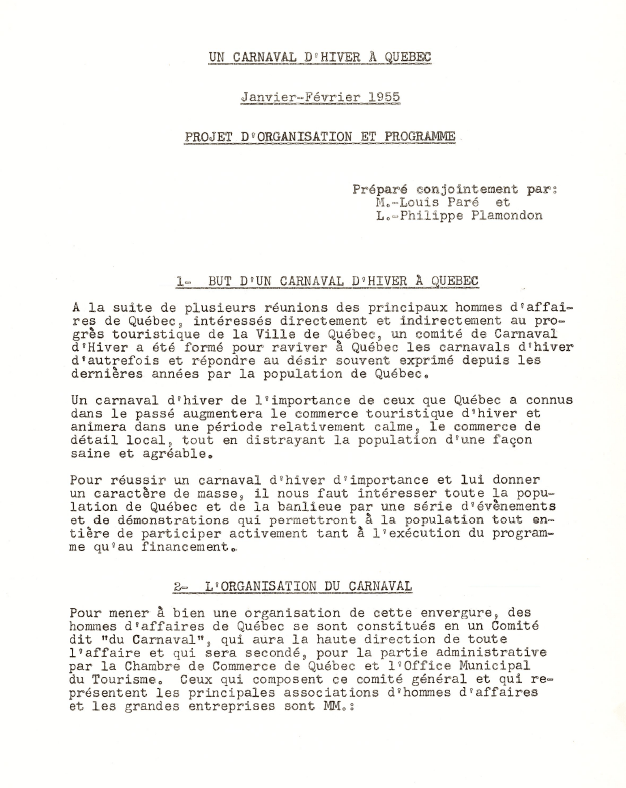
The Presidents Since 1954
The first presentation of the modern Carnival took place in the winter of 1955.
Between 1955 and 1960, the event was orchestrated by members of the business community, led by the executive committee and the Carnival committees.
Mr. Henri F. Béique (President of the Executive) and Mr. Alfred F. Mercier co-chaired the Carnival in 1955.
The executive committee, pioneers of the modern Carnival, was formed at that time in 1955:
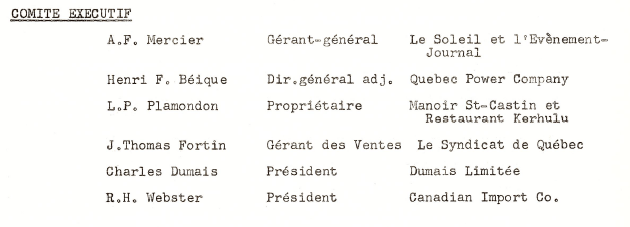
Here, an archive image of the minutes from an Executive meeting held on November 1, 1954, a few months before the presentation of the Carnival.
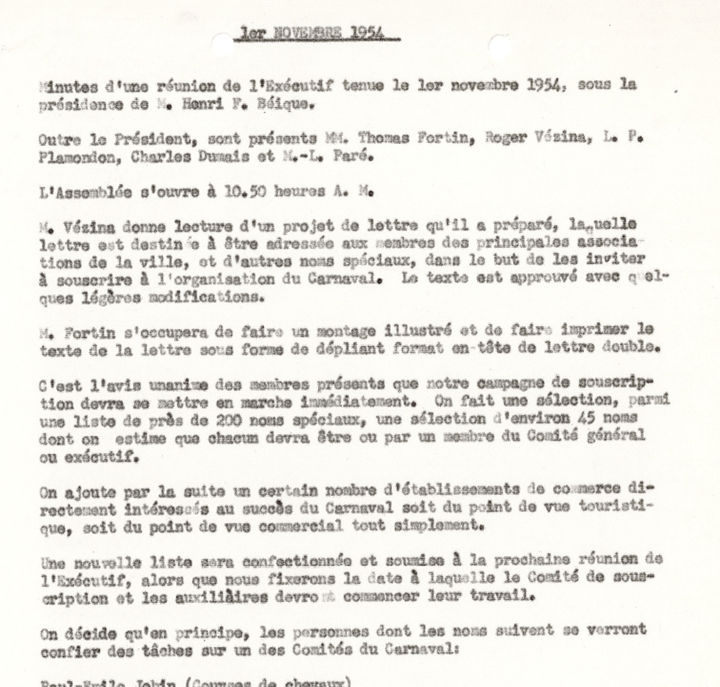
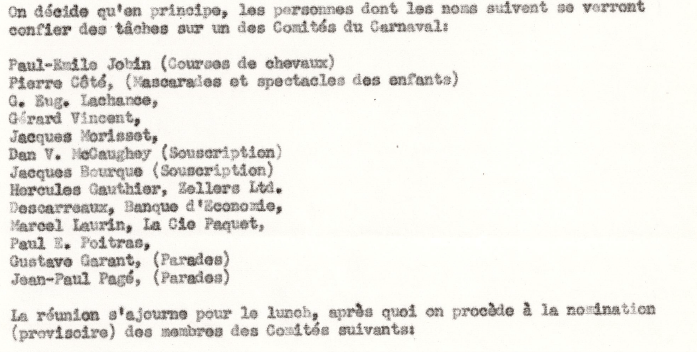
The first appointed general director of the Carnival was Mr. Marcel Rochet (1961 to 1971).
Since its beginnings, volunteer strength has remained essential to the festival. Even today, hundreds of volunteers get involved in the Carnival annually; this involvement is crucial to the success of the event.




